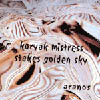 Diametrically opposite of the other recent Aranos album, Tax, here is a sprawling 65-minute track of studio processing and electronics wizardry. Different by no means inferior, however, and I would characterize this as a more complex work that has many layers to examine.
Diametrically opposite of the other recent Aranos album, Tax, here is a sprawling 65-minute track of studio processing and electronics wizardry. Different by no means inferior, however, and I would characterize this as a more complex work that has many layers to examine.
Visibly the two recent releases couldn’t show their differences more overtly: Tax in its Spartan, clinical digipak while Koryak comes in an origami like foldout sleeve of melted distorted colors, and a bit of purely abstract text in the center of the sleeve, as opposed to the everyman lyrics on Tax.
The album opens with extremely quiet pastiches of electronic hum before a variety of electronic pulses and tones arrive like distant high frequency beacons. As these increase in volume and become more pronounced, it resembles what everyone in the 1960s thought computers of the future would sound like, I can almost imagine the banks of flashing lights and other cheap visual effects. Through this pulse, a wash of symphonic elements, thick and rich tones begin to emerge and become the focus.
Even at its hour-plus duration, the piece never stays static, but continues to waver and mutate like the abstract patterns on the sleeve. The one constant that remains is the sonic meshing of the traditional orchestral instrumentation used as the backing of the track with the digital manipulation and modified tones created by the studio setting. The description of the album is that it was written for three double basses, four violins, a viola, zither, and drum, which could very well be the case considering the depth of sound going on here. Sections where a subtly treated violin, though layered and treated to sound like a swarm of insects, retains its natural color while paired with a rhythmic segment that resembles a skipping CD.
I wouldn’t characterize this as a “dark” type work by any means, but segments of sound run through a dingy, cheap spring reverb tank do make the work feel a bit darker and more sinister, exploiting a character that was prominent in some of the best elements of the early days of industrial. This mood doesn’t last long and is soon uplifted by stuttering pitch-stretched samples and other rhythmic pulses before ending in a bed of lush, beautiful strings that are left mostly untreated by the studio.
Koryak… is one of those works that simply requires multiple listenings, because there is so much going on in the mix, both at the micro and macro level, that there is almost some new nuance to be discovered with each and every listening.
samples:
Read More

